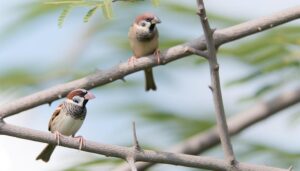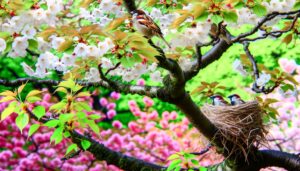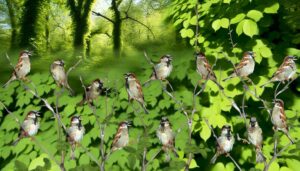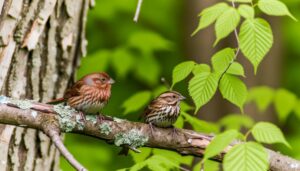3 Simple Steps to Draw a Song Sparrow
To draw a Song Sparrow, start by gathering drawing paper, a variety of pencils, and an eraser. Begin with an oval shape for the body and a smaller one for the head.
Add the wings and tail using elongated shapes. Focus on the rounded head, short bill, and plump body with slender legs.
Draw the small, sharp beak and dot-like eyes. For realism, gradually build up shaded layers with darker tones for depth, paying attention to the intricate browns, grays, and whites of the feathers.
Plot out natural posture for authenticity. Continue for detailed techniques and shading secrets that bring the sparrow to life.
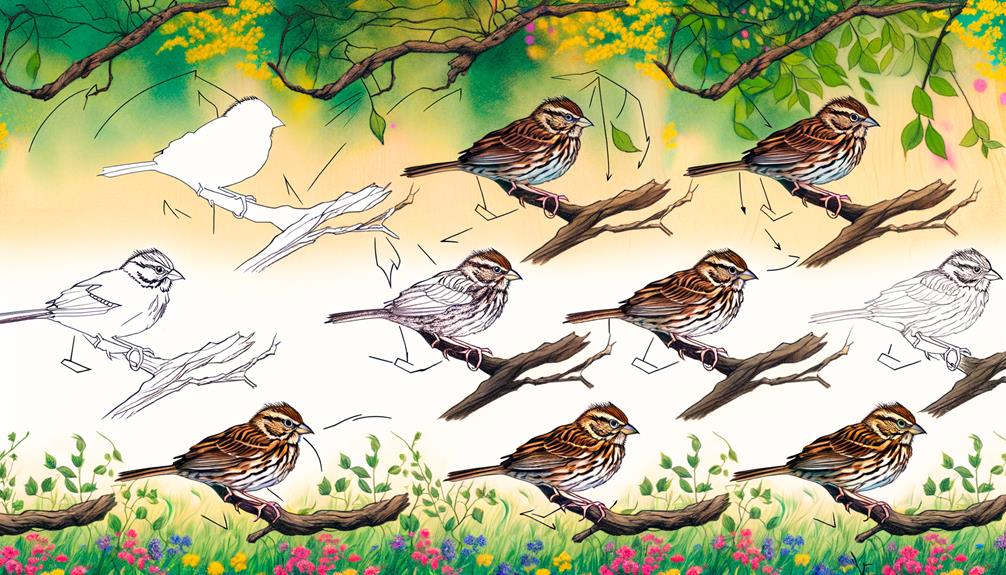
Key Takeaways
- Start by sketching an oval shape for the body and a smaller oval for the head.
- Add the main features: beak, eyes, wings, legs, and tail, ensuring realistic proportions.
- Outline intricate patterns on the Song Sparrow's feathers using reference images for accuracy.
- Use light shading initially, then build up darker tones for depth and three-dimensionality.
- Blend shades smoothly and highlight certain areas to enhance realism and create a lifelike drawing.
Gather Your Materials
First, make certain you have all the necessary materials: top-notch drawing paper, a variety of pencils, a rubber, and a reference image of a Song Sparrow. High-quality drawing paper will allow for smooth pencil strokes and erasing without damaging the surface.
A range of pencils, from hard (H) to soft (B), provides different shades and textures. A rubber is essential for correcting mistakes and refining details.
The reference image should be clear and detailed, capturing the unique features of the Song Sparrow. Having these materials ready guarantees you can focus on capturing the bird's intricate patterns and delicate forms without interruption.
Proper preparation sets the stage for a successful drawing session, allowing creativity and precision to flourish.
Study Song Sparrow Anatomy
Understanding the Song Sparrow's anatomy is vital for capturing its characteristic features accurately. Observing the bird closely, one notes its rounded head and short bill, ideal for seed eating. Its body is plump, with a slightly rounded chest and a medium-length tail often cocked at an angle. The wings are relatively short and rounded, aiding in quick, agile movements through bushes.
Feathers play a pivotal role; the Song Sparrow's intricate patterns of browns, grays, and whites create a distinctive look. The dark streaks on its chest converge into a central spot, a key identifier. Its legs and feet are slender, often gripping thin branches.
Noting these anatomical details helps in rendering a lifelike and recognizable Song Sparrow.
Sketch Basic Shapes
To begin sketching the Song Sparrow, one should start by outlining the main body with an oval shape.
Next, adding a smaller oval on top helps to define the head.
For the wings, a series of elongated shapes can be used to capture their structure and positioning accurately.
Outline Main Body
Begin by outlining a small oval for the head and a larger, elongated oval for the body to capture the basic shape of the Song Sparrow. Make sure the head oval is slightly tilted, reflecting the bird's natural posture. The connection between these two shapes should be seamless, indicating the neck area.
To add detail:
- Head Details:
Sketch a small beak at the front of the head oval.
- Body Contour:
Extend lines from the body oval to form the tail.
- Leg Placement:
Draw thin lines beneath the body for the legs.
- Eye Position:
Position a small circle within the head oval for the eye.
These steps will set the foundation for a realistic and proportionate Song Sparrow illustration.
Define Wing Structure
With the basic body outline established, sketch the primary shapes for the wings by drawing elongated, curved triangles extending from the sides of the body oval. These triangles should taper towards the tips, mimicking the streamlined form of a song sparrow's wings.
Start the triangles slightly below the midline of the body to capture the natural wing position. Guarantee the triangles' bases are wider, gradually narrowing as they extend outward. This shape helps represent the layering of feathers.
Pay attention to symmetry; both wings should mirror each other in size and shape. By capturing these initial shapes accurately, you lay a solid foundation for adding finer details like feather textures and defining the wing's individual segments later.
Outline the Sparrow
Start by sketching a simple oval shape for the sparrow's body, making sure to leave enough space on the paper for the head and tail. This foundational shape will help you get the proportions right.
Next, pay attention to the curve of the back and belly, giving the sparrow a natural posture.
To outline the sparrow accurately, follow these steps:
- Draw a small circle for the head, slightly overlapping the top of the oval.
- Extend the tail from the lower end of the oval with tapered lines, creating a fan shape.
- Sketch the wings by adding curved lines along the sides of the oval.
- Include thin, straight lines for the legs and feet beneath the body.
These elements will create a balanced and realistic outline.
Draw the Head
Carefully observe the small circle you drew for the head and add a slightly curved line at the top for the crown.
Next, draw a small, sharp beak extending from the front of the circle. Make sure the beak has a slight downward curve.
For the eyes, place two small dots slightly above and behind the beak, ensuring they're symmetrical. Add a short line above each eye to indicate the eyebrows.
Draw a subtle line from the beak to the back of the head to form the cheek.
Add Wing Details
To add wing details, the artist should first define the feather patterns, focusing on the intricate layers and textures.
They should then highlight the wing contours to give a sense of depth and movement.
Define Feather Patterns
One should focus on the intricate layering of the feathers to accurately portray the Song Sparrow's distinct wing patterns. Observing the subtle variations in color and texture is essential. Note how the primary feathers are longer and darker, while the secondary feathers exhibit lighter, more nuanced tones.
To define these feather patterns effectively, consider the following steps:
- Study Reference Images: Examine high-quality photos to understand the feather arrangement.
- Sketch Lightly: Start with a gentle outline to map out feather placement.
- Add Details Gradually: Layer details from large feathers to smaller ones.
- Use Varied Strokes: Employ short, quick strokes for texture and longer lines for flowing feathers.
This method guarantees an accurate and detailed depiction of the Song Sparrow's wings.
Highlight Wing Contours
The artist should emphasize the natural curves and shapes of the Song Sparrow's wings to bring out their elegant contours. They should start by lightly sketching the primary flight feathers, ensuring they fan out symmetrically from the bird's body.
Observing reference images closely, the artist can then add the secondary feathers, which overlap slightly with the primaries. It's essential to highlight the subtle bends and angles in the feathers, capturing the dynamic motion of the wings even in a still image.
Each feather should be distinct yet harmonious, contributing to the overall flow. A few delicate lines can indicate the feather shafts, while gentle shading adds depth and dimension. This attention to detail brings the Song Sparrow's wings to life.
Define Tail Feathers
Starting with the base of the tail, observe how the feathers fan out symmetrically, creating a balanced and structured appearance. Each feather should taper gently to a point, contributing to the bird's streamlined look.
To achieve this, follow these steps:
- Sketch the Central Feathers: Begin with the longest, central feathers. These should be straight and slightly tapered.
- Incorporate Adjacent Feathers: Draw the feathers on either side of the central ones. They should be slightly shorter and curve gently outward.
- Define the Outer Feathers: These feathers are the shortest and most curved, providing the tail with its fan-like shape.
- Enhance the Feather Edges: Add subtle lines to indicate the feather's texture and individual barbs.
Careful attention to these details guarantees accuracy and realism.
Finalize and Shade
To bring the Song Sparrow to life, meticulously add shading to emphasize depth and texture in the feathers and body.
Begin by identifying where natural light hits the bird, leaving lighter areas. Use a soft pencil to apply gentle, even pressure for the shaded regions.
Focus on the subtle variations in the plumage, creating a gradient from dark to light. Pay particular attention to the wings and tail, where shadows are more pronounced.
To achieve realism, blend the shades with a blending stump or tissue. Highlight the eyes with a small, bright spot to mimic reflection.
Make sure the legs and beak have slight shadows to enhance their three-dimensional appearance. This careful shading will make the Song Sparrow appear lifelike and dynamic.
Conclusion
In wrapping up, anyone can master drawing a song sparrow with practice and patience. Consider Sarah, an aspiring artist who followed these steps meticulously.
She began with simple shapes and gradually added intricate details, creating a lifelike portrayal of the bird. By observing real sparrows in her backyard, she refined her shading and texture techniques.
Her final piece, a detailed and vibrant song sparrow, showcases how structured guidance and keen observation can lead to remarkable results.


